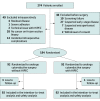Survival After Hyperthermic Intraperitoneal Chemotherapy and Primary or Interval Cytoreductive Surgery in Ovarian Cancer: A Randomized Clinical Trial
- PMID: 35262624
- PMCID: PMC8908225
- DOI: 10.1001/jamasurg.2022.0143
Survival After Hyperthermic Intraperitoneal Chemotherapy and Primary or Interval Cytoreductive Surgery in Ovarian Cancer: A Randomized Clinical Trial
Abstract
Importance: Ovarian cancer has the highest mortality rate among gynecologic malignant tumors. Data are lacking on the survival benefit of hyperthermic intraperitoneal chemotherapy (HIPEC) in women with ovarian cancer who underwent primary or interval cytoreductive surgery.
Objective: To assess the clinical benefit of HIPEC after primary or interval maximal cytoreductive surgery in women with stage III or IV primary advanced ovarian cancer.
Design, setting, and participants: In this single-blind randomized clinical trial performed at 2 institutions in South Korea from March 2, 2010, to January 22, 2016, a total of 184 patients with stage III or IV ovarian cancer with residual tumor size less than 1 cm were randomized (1:1) to a HIPEC (41.5 °C, 75 mg/m2 of cisplatin, 90 minutes) or control group. The primary end point was progression-free survival. Overall survival and adverse events were key secondary end points. The date of the last follow-up was January 10, 2020, and the data were locked on February 17, 2020.
Exposures: Hyperthermic intraperitoneal chemotherapy after cytoreductive surgery.
Main outcomes and measures: Progression-free and overall survival.
Results: Of the 184 Korean women who underwent randomization, 92 were randomized to the HIPEC group (median age, 52.0 years; IQR, 46.0-59.5 years) and 92 to the control group (median age, 53.5 years; IQR, 47.5-61.0 years). After a median follow-up of 69.4 months (IQR, 54.4-86.3 months), median progression-free survival was 18.8 months (IQR, 13.0-43.2 months) in the control group and 19.8 months (IQR, 13.7-55.4 months) in the HIPEC group (P = .43), and median overall survival was 61.3 months (IQR, 34.3 months to not reported) in the control group and 69.5 months (IQR, 45.6 months to not reported) in the HIPEC group (P = .52). In the subgroup of interval cytoreductive surgery after neoadjuvant chemotherapy, the median progression-free survival was 15.4 months (IQR, 10.6-21.1 months) in the control group and 17.4 months (IQR, 13.8-31.5 months) in the HIPEC group (hazard ratio for disease progression or death, 0.60; 95% CI, 0.37-0.99; P = .04), and the median overall survival was 48.2 months (IQR, 33.8-61.3 months) in the control group and 61.8 months (IQR, 46.7 months to not reported) in the HIPEC group (hazard ratio, 0.53; 95% CI, 0.29-0.96; P = .04). In the subgroup of primary cytoreductive surgery, median progression-free survival was 29.7 (IQR, 17.2-90.1 months) in the control group and 23.9 months (IQR, 12.3-71.5 months) in the HIPEC group, and the median overall survival was not reached in the control group and 71.3 months (IQR, 45.6 months to not reported) in the HIPEC group.
Conclusions and relevance: The addition of HIPEC to cytoreductive surgery did not improve progression-free and overall survival in patients with advanced epithelial ovarian cancer. Although the results are from a subgroup analysis, the addition of HIPEC to interval cytoreductive surgery provided an improvement of progression-free and overall survival.
Trial registration: ClinicalTrials.gov Identifier: NCT01091636.
Conflict of interest statement
Figures



Comment in
-
Hyperthermic Intraperitoneal Chemotherapy for the Treatment of Epithelial Ovarian Cancer.JAMA Surg. 2022 May 1;157(5):383. doi: 10.1001/jamasurg.2022.0156. JAMA Surg. 2022. PMID: 35262650 No abstract available.
-
Perspectives on Hyperthermic Intraperitoneal Chemotherapy for Advanced Ovarian Cancer.JAMA Surg. 2022 Oct 1;157(10):970. doi: 10.1001/jamasurg.2022.2940. JAMA Surg. 2022. PMID: 35895050 No abstract available.
-
Perspectives on Hyperthermic Intraperitoneal Chemotherapy for Advanced Ovarian Cancer-Reply.JAMA Surg. 2022 Oct 1;157(10):970-971. doi: 10.1001/jamasurg.2022.2941. JAMA Surg. 2022. PMID: 35895070 No abstract available.
-
Perspectives on Hyperthermic Intraperitoneal Chemotherapy for Advanced Ovarian Cancer.JAMA Surg. 2022 Oct 1;157(10):969-970. doi: 10.1001/jamasurg.2022.2939. JAMA Surg. 2022. PMID: 35895071 No abstract available.

